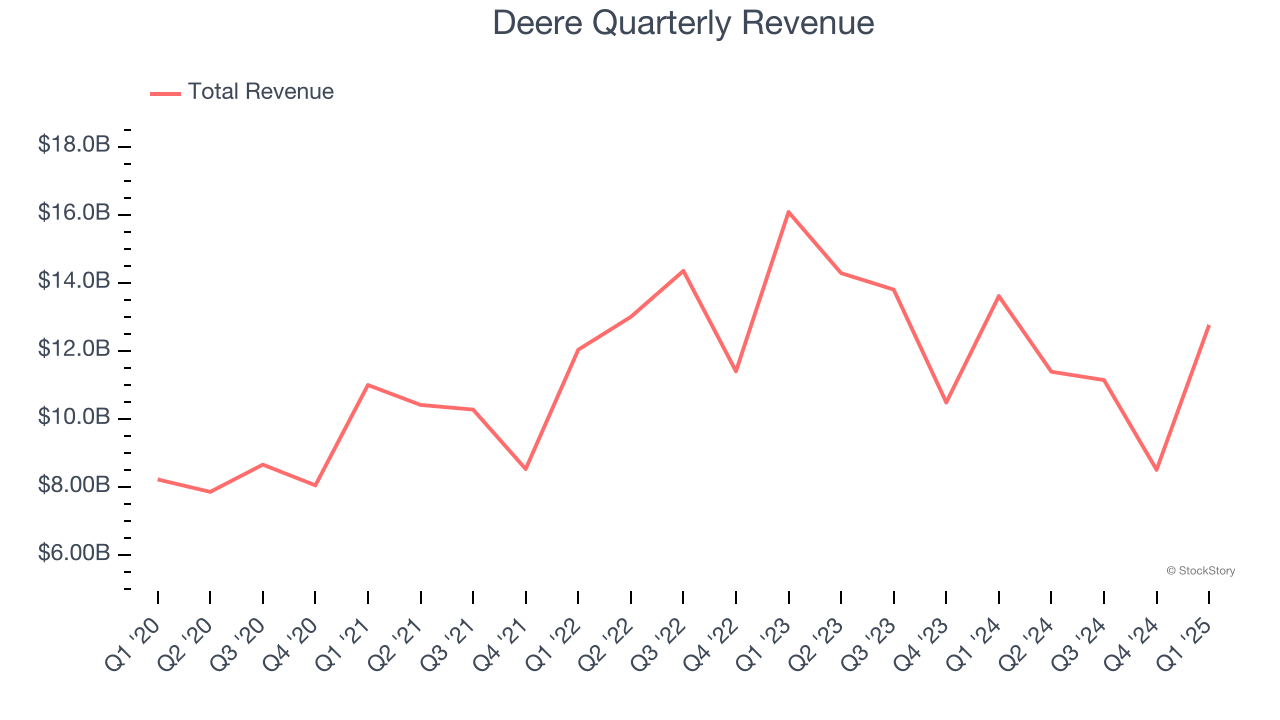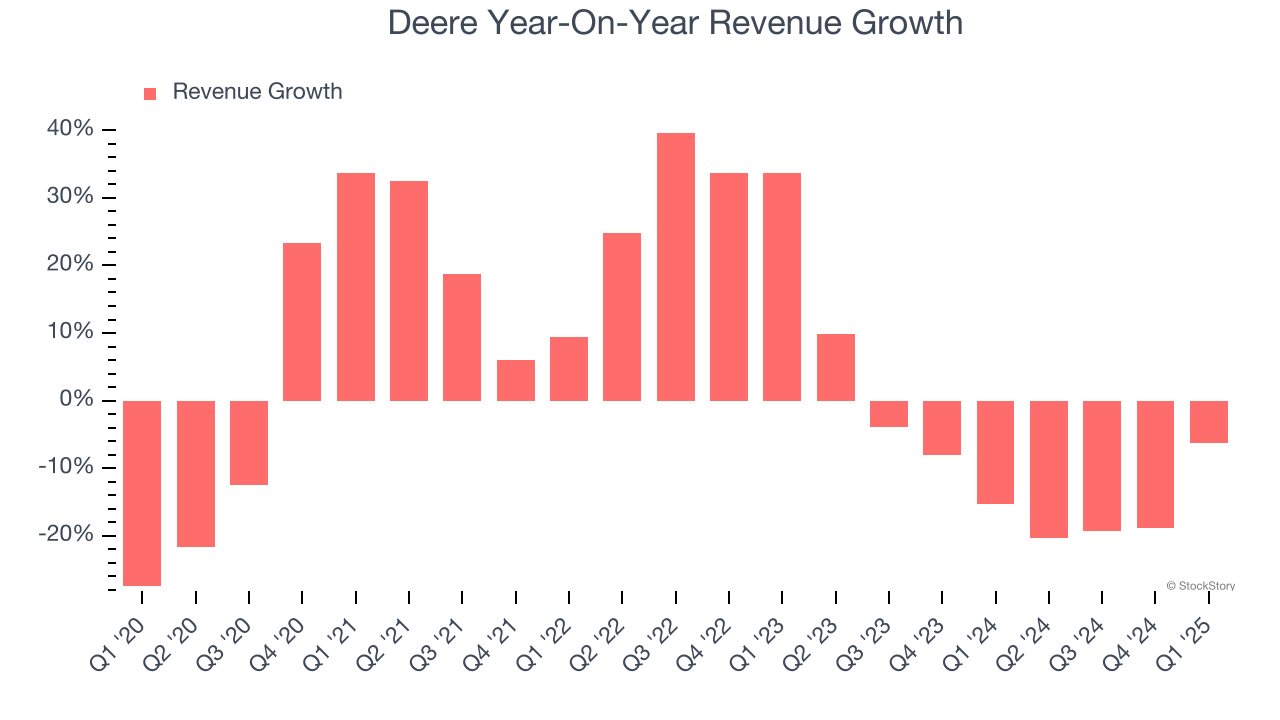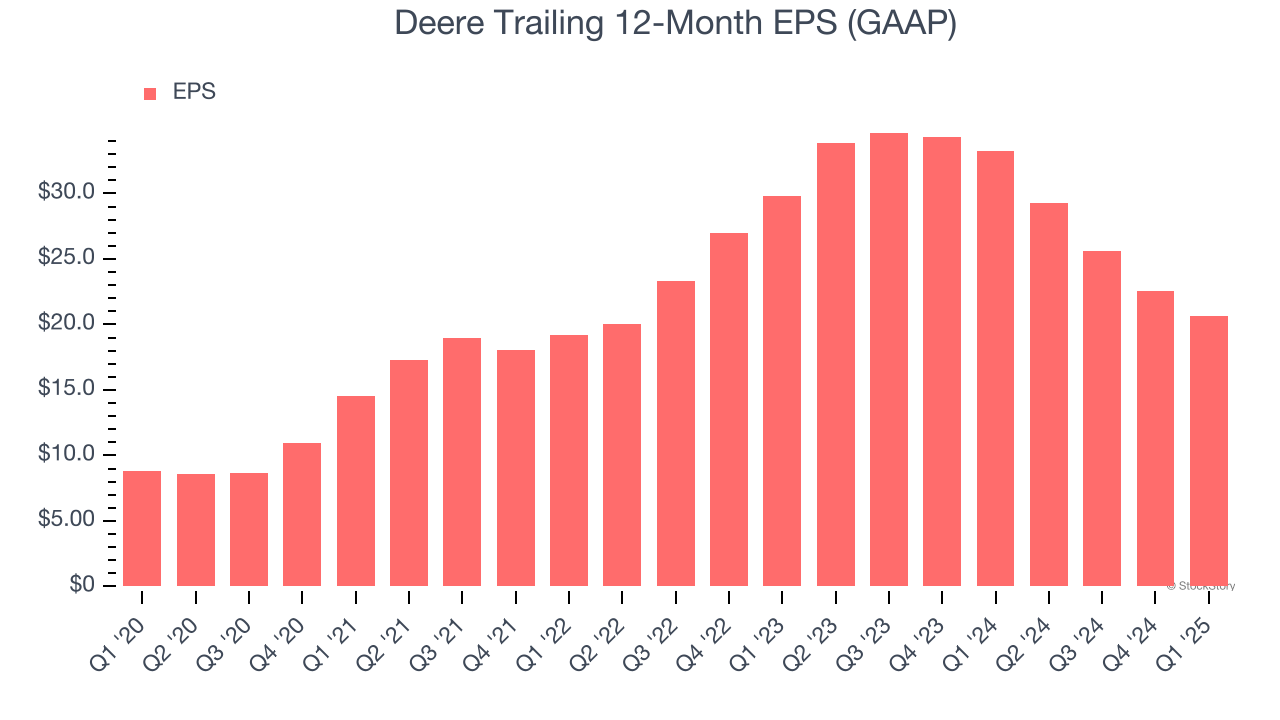
Agricultural and construction machinery company Deere (NYSE: DE) reported Q1 CY2025 results topping the market’s revenue expectations, but sales fell by 6.2% year on year to $12.76 billion. Its GAAP profit of $6.64 per share was 17.8% above analysts’ consensus estimates.
Is now the time to buy Deere? Find out by accessing our full research report, it’s free.
Deere (DE) Q1 CY2025 Highlights:
- Revenue: $12.76 billion vs analyst estimates of $12.37 billion (6.2% year-on-year decline, 3.2% beat)
- EPS (GAAP): $6.64 vs analyst estimates of $5.64 (17.8% beat)
- 2025 guidance: Production & Precision, Construction & Forestry, Financial Services unchanged, Small Ag & Turf now down 10-15% vs down 10% previously
- Operating Margin: 26.7%, up from 22.8% in the same quarter last year
- Free Cash Flow Margin: 11.7%, up from 10% in the same quarter last year
- Market Capitalization: $135 billion
Company Overview
Revolutionizing agriculture with the first self-polishing cast-steel plow in the 1800s, Deere (NYSE: DE) manufactures and distributes advanced agricultural, construction, forestry, and turf care equipment.
Sales Growth
A company’s long-term performance is an indicator of its overall quality. Even a bad business can shine for one or two quarters, but a top-tier one grows for years. Unfortunately, Deere’s 4.8% annualized revenue growth over the last five years was tepid. This fell short of our benchmark for the industrials sector and is a tough starting point for our analysis.

We at StockStory place the most emphasis on long-term growth, but within industrials, a half-decade historical view may miss cycles, industry trends, or a company capitalizing on catalysts such as a new contract win or a successful product line. Deere’s performance shows it grew in the past but relinquished its gains over the last two years, as its revenue fell by 10.6% annually. 
We can dig further into the company’s revenue dynamics by analyzing its three most important segments: Production & Precision Agriculture , Construction & Forestry , and Small Agriculture & Turf, which are 41%, 23.1%, and 23.5% of revenue. Over the last two years, Deere’s revenues in all three segments declined. Its Production & Precision Agriculture revenue (tractors, harvesters, tillage) averaged year-on-year decreases of 36.7% while its Construction & Forestry (loaders, excavators, dump trucks) and Small Agriculture & Turf (mowers and other small vehicles) revenues averaged drops of 10.6% and 16.2%.
This quarter, Deere’s revenue fell by 6.2% year on year to $12.76 billion but beat Wall Street’s estimates by 3.2%.
Looking ahead, sell-side analysts expect revenue to grow 4.5% over the next 12 months. Although this projection indicates its newer products and services will spur better top-line performance, it is still below average for the sector.
Software is eating the world and there is virtually no industry left that has been untouched by it. That drives increasing demand for tools helping software developers do their jobs, whether it be monitoring critical cloud infrastructure, integrating audio and video functionality, or ensuring smooth content streaming. Click here to access a free report on our 3 favorite stocks to play this generational megatrend.
Operating Margin
Deere has been a well-oiled machine over the last five years. It demonstrated elite profitability for an industrials business, boasting an average operating margin of 20.4%. This result was particularly impressive because of its low gross margin, which is mostly a factor of what it sells and takes huge shifts to move meaningfully. Companies have more control over their operating margins, and it’s a show of well-managed operations if they’re high when gross margins are low.
Analyzing the trend in its profitability, Deere’s operating margin might fluctuated slightly but has generally stayed the same over the last five years. This raises questions about the company’s expense base because its revenue growth should have given it leverage on its fixed costs, resulting in better economies of scale and profitability.

This quarter, Deere generated an operating profit margin of 26.7%, up 3.9 percentage points year on year. Since its gross margin expanded more than its operating margin, we can infer that leverage on its cost of sales was the primary driver behind the recently higher efficiency.
Earnings Per Share
Revenue trends explain a company’s historical growth, but the long-term change in earnings per share (EPS) points to the profitability of that growth – for example, a company could inflate its sales through excessive spending on advertising and promotions.
Deere’s EPS grew at an astounding 18.6% compounded annual growth rate over the last five years, higher than its 4.8% annualized revenue growth. However, this alone doesn’t tell us much about its business quality because its operating margin didn’t expand.

Diving into Deere’s quality of earnings can give us a better understanding of its performance. A five-year view shows that Deere has repurchased its stock, shrinking its share count by 14%. This tells us its EPS outperformed its revenue not because of increased operational efficiency but financial engineering, as buybacks boost per share earnings. 
Like with revenue, we analyze EPS over a shorter period to see if we are missing a change in the business.
For Deere, its two-year annual EPS declines of 16.7% mark a reversal from its (seemingly) healthy five-year trend. We hope Deere can return to earnings growth in the future.
In Q1, Deere reported EPS at $6.64, down from $8.53 in the same quarter last year. Despite falling year on year, this print easily cleared analysts’ estimates. Over the next 12 months, Wall Street expects Deere’s full-year EPS of $20.67 to shrink by 5.2%.
Key Takeaways from Deere’s Q1 Results
We enjoyed seeing Deere beat analysts’ revenue expectations this quarter. We were also glad its EPS outperformed Wall Street’s estimates. The company's 2025 guidance largely remained unchanged, although Small Ag & Turf is expected to be a little worse than previously thought. Zooming out, we think this was a solid print. The stock traded up 1.2% to $503.10 immediately following the results.
Deere may have had a good quarter, but does that mean you should invest right now? What happened in the latest quarter matters, but not as much as longer-term business quality and valuation, when deciding whether to invest in this stock. We cover that in our actionable full research report which you can read here, it’s free.







